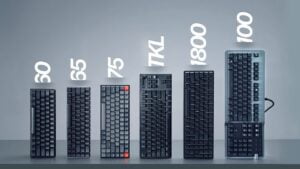AMD Ryzen 5 1600X & 1500X Performance Review
Share:
AMD’s B350 Chipset, A Perfect Fit for Ryzen 5?
Back when I looked at the Ryzen 7 processors I ended up taking a good amount of time to explain AMD’s new platform and the motherboards it would bring to the table. At the time I focused primarily on the higher end X370 boards since they seemed to be a good fit for the 8-core CPUs but with Ryzen 5, its time to give B350 its time in the limelight.
In many ways the B350 platform is a more affordable and cut-down version of the X370 but unlike Intel’s H-series, it retains the overclocking features of its big brother. The actually differences between the X370 and B350 primarily revolve around the latter’s lack of higher bandwidth dual GPU support but there are several other more nuanced changes as well.
Actually, let’s talk about B350 and Crossfire / SLI compatibility for a second since there seem to be some misconceptions about it. In order to distinguish these motherboards from X370 AMD doesn’t allow for the Ryzen processor’s 16 PCI-E 3.0 lanes to be split into two x8 pathways when two graphics cards are installed. Instead, Ryzen motherboards will have a primary x16 slot and chipset-supported secondary x16 mechanical slot that operates at PCI-E 2.0 x4 speeds.
Since SLI requires a minimum of a x8 lane allocation for functionality, that’s immediately off the table. However, motherboard vendors can still claim “Crossfire” support since its minimal spec requires just a quartet of PCI-E lanes. However, with that secondary slot being fed by the chipset and operating at just 2.0 x4 speeds, you certainly wouldn’t want to use it for a second graphics card.

Back when I first looked at Ryzen, I mentioned the ASUS X370 Crosshair motherboard was one of those “everything but the kitchen sink” type of products that had a wide scattershot of features, many of which people would never actually use. As you might expect B350 motherboards are being targeted towards folks who are looking for the basics but still want a good amount of future-proofing in their systems. If you’ll actually need eight or more SATA ports or you know a dual GPU setup may be a possibility sometime down the road then stop reading here and grab an X370.
Let’s take this $110 MSI B350 Tomahawk for example since it would perfectly fit what 90% of the market needs right now. It still has the looks of a higher end motherboard and the feature set backs that up with add-ons like an RGB header for MSI Mystic Light support, a convenient auto-overclocking app and high level integrated audio.

Due to Ryzen’s native support of NVMe storage at PCI-E 3.0 x4 speeds, MSI has also included an M.2 slot that’s rated for operation at 32Gbps. This is actually a key focus for AMD’s Ryzen architecture since it will allow all motherboards to implement high bandwidth storage without eating into the chipset’s limited PCI-E lane allocation.
On this particular board, the primary PCI-E setup hasn’t changed from what I described above but MSI has provided a few more details about it s functionality. The top x16 slot –which is protected with MSI’s so-called Steel Armor- remains locked at those speeds regardless of what else is plugged in while the same goes for the quartet of 3.0 lanes directed to the M.2 slot.
The lower x16 mechanical slot operates at x4 electrical speeds UNLESS there is an add-in card within one of the x1 slots. If one or two of those are installed, that x4 bandwidth gets cut in half to PCI-E 2.0 x2 speeds. That’s yet another reason why you wouldn’t want to install a second graphics card; it would really limit your secondary expansion capabilities.

The backplate I/O area on B350 boards will feature a very limited number of connectors, at least when compared against higher level offerings. The reason for this is pretty simple: this more budget friendly chipset has a limited number of native USB ports and general purpose PCI-E lanes. Also remember neither the Ryzen processors nor their associated chipsets natively support USB 3.1 Gen2 so if a motherboard manufacturer wants to add that functionality, they will need to do so through a third party controller which utilizes the chipset’s PCI-E interface.
MSI has done their best to maximize the Tomahawk’s port selection. This board has an on-school but lag-busting mouse connector, a pair of standard USB 2.0 ports and display outputs consisting of VGA, DVI and HDMI for AMD’s upcoming Zen-based APUs. Unfortunately, there’s no DisplayPort.
Moving on, there’s also a trio of USB 3.1 standard connectors and a lone USB 3.1 Type-C. Unfortunately, MSI has chosen to avoid adding an ASMedia or similar secondary controller for Gen2 functionality so all of these ports remain at the slower Gen1 (or USB 3.0) speed and output power potential.
All in all though the MSI B350 Tomahawk looks like a perfect fit for Ryzen 5 processors. It has exactly the connectivity people would be looking for without any excess “fluff” that you would pay for but never use. It even allows for a decent amount of overclocking. What’s not to like about that?




